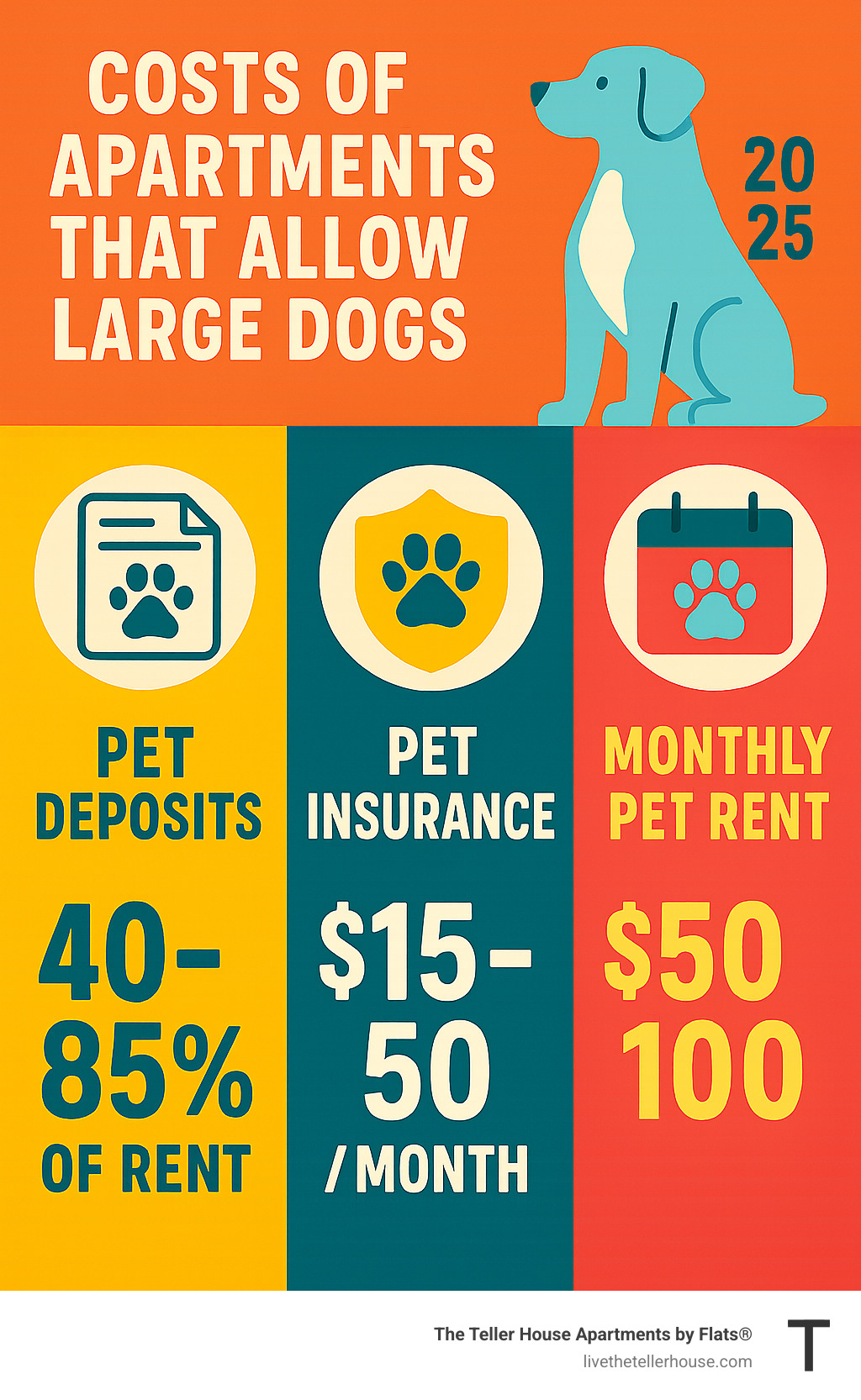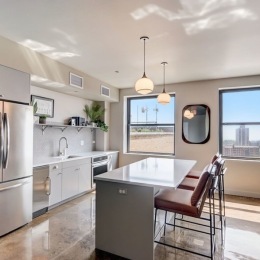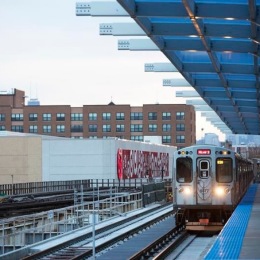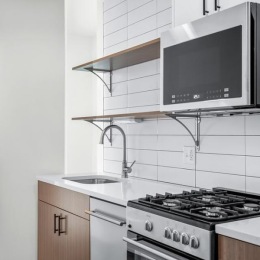Why Finding Apartments That Allow Large Dogs Can Be Challenging
Apartments that allow large dogs are becoming harder to find as pet ownership rises across the country. The average weight limit for dogs in apartments ranges from 25 to 50 pounds, making it tough for owners of Great Danes, German Shepherds, and other large breeds to secure housing.
Quick Answer for Large Dog Owners:
- Search Strategy: Use filters like "no weight limit" and "dog-friendly" on rental sites
- Best Options: Single-family homes and private landlords offer more flexibility
- Prepare Documentation: Pet resume, vaccination records, and liability insurance
- Expect Extra Costs: Monthly pet rent ($50-$100) plus deposits (40-85% of rent)
- Target Amenities: Look for dog parks, wash stations, and ground-floor units
More than half of rental units in major cities like Los Angeles, Chicago, and San Francisco allow pets, but many still impose breed or weight restrictions. Property managers worry about liability, insurance costs, and potential damage from larger animals.
The good news? Pet-friendly apartments are more common than ever due to rising pet ownership rates. Many apartment communities now offer features like pet washing stations and dog parks - especially beneficial for large dog owners who need proper exercise space.
Your search doesn't have to end in frustration. With the right approach, documentation, and search strategy, you can find a home that welcomes both you and your four-legged companion.
State of the Market: How Common Are Apartments That Allow Large Dogs
Finding apartments that allow large dogs has become a real challenge in today's rental market. While pet ownership continues to rise across the country, the reality for large dog owners isn't quite as rosy as the overall pet-friendly statistics might suggest.
Here's the thing: more than half of rental units in major cities now welcome pets, which sounds fantastic at first glance. But dig a little deeper, and you'll find that most of these pet-friendly properties come with weight restrictions that effectively shut out larger breeds. The typical weight limit hovers between 25 and 50 pounds, which means your Golden Retriever or Labrador might be pushing the boundaries before you even start looking.
The demand for pet-friendly housing has definitely pushed more landlords to open their doors to four-legged tenants. After all, pet owners represent a huge portion of potential renters, and turning them away means losing out on a significant market. But here's where it gets tricky for large dog owners: liability concerns and insurance premiums often drive property managers to set those frustrating weight limits.
Why Restrictions Exist
Let's be honest about why landlords put these restrictions in place. Understanding their perspective can actually help you address their concerns when you're apartment hunting.
Property damage sits at the top of most landlords' worry lists. A larger dog could potentially cause more damage to floors, doors, or landscaping than a smaller one. While your gentle giant might be perfectly well-behaved, property managers often think about worst-case scenarios rather than individual dogs.
Insurance headaches create another major hurdle. Many insurance companies charge higher premiums or flat-out refuse coverage for properties that allow certain breeds. When your insurance costs go up, that directly impacts the property owner's bottom line.
Noise concerns also play a role, especially in apartment buildings where sound travels between units. Larger dogs typically have deeper, louder barks that can carry through walls and potentially disturb neighbors.
Breed-specific legislation adds another layer of complexity. Some cities have ordinances affecting certain breeds, which creates legal complications that landlords would rather avoid entirely.
Typical Weight & Breed Caps
Most apartments that allow large dogs set their weight limits somewhere between 25 and 50 pounds per pet. This immediately rules out many beloved large breeds that families want to keep.
German Shepherds typically weigh 50 to 90 pounds, putting them over most limits. Rottweilers at 80 to 135 pounds don't stand a chance with standard restrictions. Great Danes, despite often being gentle giants, can weigh 110 to 175 pounds, making them nearly impossible to house in traditional apartment communities.
Other commonly restricted breeds include Pit Bulls and American Staffordshire Terriers, Doberman Pinschers, Chow Chows, and Huskies or Malamutes. These restrictions often have nothing to do with the individual dog's temperament or training level.
But here's some hope: we've seen exceptions to these rules. Some communities make case-by-case decisions, especially when owners can provide documentation of training, temperament testing, and responsible ownership. A growing number of progressive properties have started focusing on the dog's behavior and the owner's responsibility rather than just breed or weight restrictions.
The landscape varies quite a bit depending on where you're looking. Cities like Chicago, Los Angeles, and San Francisco have plenty of pet-friendly options overall, but finding ones that truly welcome large dogs still requires patience and persistence.
Finding & Filtering Apartments That Allow Large Dogs
Finding the perfect home for you and your large dog doesn't have to feel like searching for a needle in a haystack. The secret is knowing where to look and how to use the right search tools to uncover hidden gems that welcome bigger four-legged family members.
Start your hunt on major rental platforms like Apartments.com, which offer powerful filtering options specifically designed for pet owners. Look for the dog-friendly toggle and amenity checkboxes that can help you quickly identify properties that roll out the red carpet for pets. The map view feature is particularly handy - it lets you spot clusters of pet-friendly buildings in neighborhoods that might be perfect for your lifestyle.
If you're considering the Chicago area, neighborhoods like Uptown offer an ideal blend of urban convenience and dog-friendly amenities. The Neighborhood around Uptown provides excellent walkability and plenty of green spaces where large dogs can stretch their legs and burn off energy.
Don't overlook an often-forgotten resource: local rescue organizations. Many animal shelters and rescue groups keep updated lists of landlords who've successfully worked with large dog owners in the past. These connections can be gold mines for finding apartments that allow large dogs before they hit the general market. Scientific research on pet relocation stress shows that securing stable housing quickly makes the transition easier for both you and your furry companion.
Using Search Filters for Apartments That Allow Large Dogs
Getting smart with search filters can dramatically improve your success rate. Start with the obvious "pets allowed" or "dog-friendly" filters, then dig deeper into the advanced options that many renters overlook.
In the keyword search boxes, try specific phrases like "no weight limit," "large dogs welcome," or "breed-friendly." Some property managers mention their flexible pet policies in listing descriptions rather than checking standard filter boxes, so these targeted searches can uncover hidden opportunities.
Pay attention to amenity filters too. Properties that offer dog parks, pet washing stations, or designated relief areas typically have more progressive pet policies overall. These features signal that the management company understands and caters to pet owners' needs - especially those with larger dogs who require more space and facilities.
Set up saved searches with alerts for new listings that match your criteria. The rental market moves at lightning speed, and the best pet-friendly units often get snatched up within days of being listed.
Expanding the Net: Single-Family Rentals & Private Landlords
Here's where things get interesting: private landlords who own single-family homes, duplexes, or small apartment buildings often have much more flexible policies than large corporate complexes. These individual property owners can make decisions on a case-by-case basis without navigating layers of corporate red tape or blanket insurance restrictions.
Private landlords are often more interested in finding responsible, long-term tenants than strictly enforcing breed or weight limits. They have the freedom to look at you and your dog as individuals rather than checking boxes on a corporate policy sheet.
When you find a private landlord who seems open to negotiation, come prepared to showcase why you and your large dog would be ideal tenants. This personal approach often works better than trying to fit into predetermined corporate criteria, giving you much more leverage in securing a home that works for everyone involved.
Strengthening Your Application & Beating Breed/Weight Rules
When you're searching for apartments that allow large dogs, your application becomes your most powerful tool. The difference between "no" and "yes" often comes down to how well you present yourself and your furry companion as the ideal tenants.
Think of it this way: property managers see dozens of applications every week. Most pet owners submit the bare minimum - a quick form and maybe a photo. But you're going to stand out by showing that you've thought through every detail and taken responsibility seriously.
Your goal isn't just to meet their requirements. You want to make them feel confident that choosing you and your dog will be one of their best decisions. This means addressing their concerns before they even ask the questions.

The reality is that many properties have flexible policies when they meet the right applicant. Even buildings with posted breed restrictions sometimes make exceptions for well-documented, well-trained dogs. Your application package should tell that compelling story.
Crafting a Winning Pet Résumé for Apartments That Allow Large Dogs
Your dog needs a résumé just like you do. Sounds funny, but property managers love seeing organized, professional documentation that shows you take pet ownership seriously.
Start with a professional photo that shows your dog at their best. Skip the action shots or pictures that emphasize size in an intimidating way. Instead, choose a calm, friendly image that shows your dog's gentle nature. A picture of your Great Dane sitting politely or your German Shepherd with a relaxed expression works perfectly.
Include all the basic information upfront: name, breed, age, weight, spay/neuter status, and microchip details. Be honest about weight - they'll likely meet your dog during the process anyway, and honesty builds trust from the start.
Health documentation proves you're a responsible owner. Current vaccination records, recent vet exam results, and any ongoing health management plans show you prioritize your dog's wellbeing. This isn't just about meeting requirements; it demonstrates your commitment to preventing problems.
Don't underestimate training credentials. Even basic puppy kindergarten certificates show you've invested in proper socialization. Obedience class completion, therapy dog training, or specialized behavioral training certificates can completely change how property managers view your application.
Describe your dog's daily routine in detail. When do they eat? How often do they go outside? What's their exercise schedule? This helps property managers understand how your pet will fit into their community and shows you've established structure.
Include your veterinarian's contact information as a professional reference. Vets can speak to both your dog's temperament and your standards of care. If you've rented with your dog before, add references from previous landlords who can confirm you left their property in excellent condition.
Appealing Restrictions & Requesting Pet Interviews
Here's where many people give up too early. When you see breed or weight restrictions, don't automatically move to the next listing. Many property managers will consider exceptions for the right situation.
Request a meet-and-greet where they can observe your dog's behavior firsthand. A calm, well-behaved German Shepherd often overcomes initial breed concerns better than any paperwork could. Schedule this meeting when your dog is relaxed - maybe after a good walk but not when they're overly excited.
Consider offering additional security to address their damage concerns. An extra pet deposit shows you're willing to put your money where your mouth is. This financial commitment often speaks louder than promises about your dog's behavior.
Present insurance documentation that includes pet liability coverage. Some renters insurance policies specifically cover incidents involving pets, which directly addresses landlord concerns about potential problems. This shows you've thought through worst-case scenarios and prepared accordingly.
Provide multiple references from different perspectives. Previous landlords, veterinarians, dog trainers, and even neighbors can speak to your dog's good behavior and your responsible ownership. The more voices vouching for you, the stronger your case becomes.
Sometimes suggesting a trial period works wonders. Offer a probationary lease where your tenancy gets evaluated based on actual performance rather than assumptions about breed behavior. This gives nervous property managers a safety net while giving you a chance to prove yourself.
You're not just applying for housing - you're building a relationship with people who could become your neighbors and community partners. Approach the process with patience, professionalism, and genuine respect for their concerns.
Budgeting & Amenities for Big-Dog Living
Once you've found apartments that allow large dogs, it's time to crunch the numbers and understand what you're really signing up for. The truth is, apartment living with a large dog comes with extra costs that can add up quickly.
Monthly pet rent typically adds another expense to your housing budget, and pet deposits can represent a significant upfront investment. These amounts often increase for larger breeds because property managers view them as higher risk. It's not necessarily fair, but it's the reality of today's rental market.
Beyond the basic fees, apartment living with a large dog brings ongoing expenses you might not have considered. Your dog may need more frequent grooming since they're spending more time indoors. You might find yourself investing in doggy daycare or dog walker services to ensure your furry friend gets adequate exercise. Even food costs can increase as you focus on higher-quality nutrition to keep your dog healthy in a more confined environment.
The good news? Many apartment communities that welcome pets have invested heavily in amenities that make life easier for large dog owners. Pet washing stations become a game-changer when your Great Dane decides to roll in a puddle. On-site dog parks mean you don't have to drive across town for safe, off-leash exercise time.
Properties in areas like Uptown Chicago have acceptd the pet-friendly trend, offering comprehensive Amenities designed with pet owners in mind. These thoughtful additions can actually save you money in the long run while making daily life more convenient.
Must-Have Features in Large-Dog-Friendly Communities
When you're touring potential apartments, certain features should immediately catch your attention as a large dog owner. These aren't just nice-to-have perks - they're essentials that will make or break your living experience.
On-site dog parks top the list of must-have amenities. Look for fenced areas with separate sections for large and small dogs. This separation shows the property management actually understands dog behavior and wants to prevent conflicts. A well-designed dog park means your German Shepherd won't accidentally overwhelm someone's tiny Chihuahua during playtime.
Ground-floor units might cost a bit more, but they're worth every penny for large dog owners. Your dog's joints will thank you for avoiding multiple flights of stairs several times a day. Emergency situations become much easier to handle when you're not trying to carry a 100-pound dog down three flights.
Wide hallways and doorways matter more than you might think. Navigating narrow spaces with a large dog while carrying groceries or encountering neighbors becomes awkward quickly. Properties designed with larger breeds in mind provide comfortable passage for everyone.
Professional pet washing stations can save you hundreds per year in grooming costs. These aren't tiny sinks - they're designed to accommodate dogs of all sizes with proper restraints and professional-grade equipment. No more wrestling your muddy Labrador into your bathtub.
Trail access or nearby parks become essential when your living space doesn't include a backyard. Large dogs need substantial exercise, and having walking trails or green spaces within easy reach makes daily exercise routines manageable.
Sound insulation protects your relationship with neighbors. Well-insulated walls mean your dog's deeper bark won't travel as easily to adjacent units. This feature often indicates overall quality construction that benefits everyone in the building.
Responsible Apartment Living with a Large Dog
Living successfully in apartments that allow large dogs requires more intentional planning than house living. Your daily routines need to work for your dog, your neighbors, and property management.
Exercise becomes your top priority in apartment living. Large dogs typically need substantial daily activity - often more than smaller breeds. This means planning multiple walks, incorporating play sessions, and possibly scheduling weekend trips to parks or hiking trails. A tired dog is a well-behaved dog, and well-behaved dogs don't generate complaints.
Noise management requires ongoing attention. Train your dog to respond immediately to quiet commands, and address barking triggers proactively. Many large dogs bark at sounds in hallways or outside windows. White noise machines can help mask these triggers while you work on training.
Waste cleanup becomes more noticeable with larger dogs - everything is bigger, including the mess. Always carry extra cleanup bags and be prepared to handle accidents in common areas immediately. Your reputation as a responsible tenant depends on how well you manage these situations.
Socialization matters more in apartment settings where you'll regularly encounter other residents and their pets. A well-socialized large dog puts everyone at ease, while a reactive or fearful dog creates tension. Invest time in positive interactions with people and other animals.
Insurance coverage needs regular review to ensure adequate pet liability protection. Large dogs can cause more significant damage or injury if incidents occur, so your coverage should reflect this reality. Keep your policy current and understand what's covered.
Communication with management should be proactive and honest. Report any pet-related damage immediately rather than hoping it goes unnoticed. Building trust with property management protects your housing situation and helps them feel confident about their pet-friendly policies.
Frequently Asked Questions about Apartments That Welcome Large Dogs
Finding apartments that allow large dogs raises plenty of questions for pet owners navigating the rental market. Here are the most common concerns we hear from renters with larger four-legged family members.
What qualifies as a "large dog" in rental terms?
The definition of "large dog" varies more than you might expect across rental properties. Most apartment communities draw the line at 50 pounds, though some properties set their threshold as low as 25 pounds. This means your friendly 45-pound Border Collie might be welcome at one property but considered "large" at another.
Weight isn't the only factor property managers consider. Some breeds under 50 pounds face restrictions based on insurance company classifications rather than actual size. Meanwhile, certain gentle giants like Great Danes sometimes get approved despite their impressive stature, especially when owners provide strong documentation of training and temperament.
The classification often reflects insurance company definitions more than common sense. Properties working with pet-specialized insurance providers typically offer more flexible guidelines than those using standard commercial policies that paint all large breeds with the same brush.
How can I avoid or reduce extra pet fees?
While completely avoiding pet fees is rare, smart negotiation can significantly reduce your costs. The key is timing and presentation - property managers have much more flexibility during initial lease negotiations than after you've already moved in.
Negotiating during lease signing gives you the most leverage. Consider offering a longer lease commitment or higher security deposit in exchange for reduced monthly pet rent. Many property managers prefer the stability of long-term residents over short-term fee collection.
Demonstrating low risk through extensive documentation can also work in your favor. Properties sometimes offer reduced fees for certified therapy dogs, pets with professional training credentials, or animals with spotless rental histories. Your pet résumé becomes a powerful negotiating tool.
Some communities accept pet liability insurance as an alternative to hefty deposits. Monthly insurance premiums often cost less than large upfront deposit requirements, improving your cash flow while still protecting the property.
Keep an eye out for seasonal promotions too. Many apartment communities run specials during slower leasing periods that include waived or reduced pet fees - perfect timing for budget-conscious pet owners.
Are service or emotional-support animals exempt from breed/weight limits?
The rules around service animals and emotional support animals differ significantly, and understanding these distinctions can be crucial for qualifying pet owners.
Service animals receive broad protections under the Americans with Disabilities Act, regardless of breed or size. These animals must be individually trained to perform specific tasks related to a person's disability. Property managers cannot impose breed restrictions or weight limits on legitimate service animals.
Emotional support animals have more limited protections but still qualify for reasonable accommodations under fair housing laws. These animals provide therapeutic benefit through companionship rather than specific task training. While they may still face some restrictions, property managers must evaluate accommodation requests individually.
The key difference lies in training requirements. Service animals need specialized task training, while emotional support animals provide comfort through their presence. Property managers must make individual assessments and cannot automatically exclude animals based solely on breed or size when legitimate accommodation requests are involved.
However, all animals - regardless of their legal status - must still meet behavioral standards. Property managers can hold owners responsible for damage or incidents, and animals that pose direct threats to other residents may face restrictions even with accommodation requests.
Conclusion
Your journey to finding apartments that allow large dogs doesn't have to end in frustration or compromise. While the search requires more effort than finding housing for smaller pets, the right home for you and your furry family member is absolutely within reach.
The rental market has evolved significantly in recent years, with more properties recognizing that responsible pet owners make excellent tenants. Success comes down to preparation, persistence, and presenting yourself as the ideal resident that property managers want to welcome into their communities.
Start with smart search strategies using rental platform filters, but some of the best opportunities come from private landlords and smaller properties willing to evaluate each situation individually. Don't overlook historic buildings that have been converted to modern apartments - these often combine character with flexible pet policies that larger corporate complexes can't match.
Your pet résumé and documentation package will be your secret weapons in overcoming breed restrictions and weight limits. When property managers see vaccination records, training certificates, and glowing references from previous landlords, they're much more likely to see your large dog as an asset rather than a liability.
Budget for the additional costs that come with pet-friendly living, but also prioritize communities that have invested in amenities like dog parks and washing stations. These features show a genuine commitment to supporting pet owners and make apartment living much more enjoyable for both you and your dog.
In neighborhoods like Uptown Chicago, you'll find communities that understand the special bond between residents and their pets. Historic buildings transformed into luxury living spaces often provide the perfect combination of sophisticated design and pet-friendly policies that make everyone feel at home.
The Teller House represents exactly this kind of thoughtful approach to apartment living - where your entire family, including four-legged members, can truly belong. Ready to see what pet-friendly luxury living looks like? Schedule a Tour and find how the right apartment community can welcome you and your large dog with open arms.
Your search for the perfect apartment doesn't require choosing between your housing dreams and your beloved companion. With the right approach, you can find a place where both you and your large dog will thrive for years to come.









